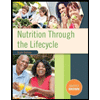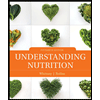
Concept explainers
To explain: The factors that may put Person M at high risk for early termination of breastfeeding.
Introduction: Breast feeding is an important phase in the life of both the mother and the infant. Breast milk provides the necessary nutrients, immunological functions and psychological support to the growing infant in his early stages of development. It also has several benefits to the mother like burning of the calories gained during pregnancy and also relaxation of the body by the release of oxytocin hormone.
Explanation of Solution
Person M is young mother, office manager, and a part-time aerobics instructor. She has delivered a healthy son vaginally without any complication. Her child is about 3.2 kg during birth time. Person M is about 5′4″ tall and she gained about 25 kg body weight during her pregnancy and has been a lacto-ovo vegetarian for past five years. Within four days of postpartum period, Person M and her family visited healthcare consultant with concerns that whether their son was getting proper nourishment or not. As per the nutrition assessment report, her son’s weight is 3 kg. The parents reported that their son nurses about every 1½ to 2 hours and he never sleeps for more than a couple of hours. Person M told that her breast milk came in on second day of postpartum period and her nipples are tender, but not uncomfortably sore. She reported about her son’s health condition. She was concern about whether she had enough milk, mostly worried about weight loss, and wants to go back to her work. The dietician told them that their son is healthy with no nutritional problems.
There are several factors that may put Person M at high risk for early termination of breastfeeding. The factors are as follows:
- • Lack of follow up appointments.
- • She wants to return to her job within 2 months that may perhaps being a cause for termination of breastfeeding because some work places do not provide facilities for the nursing mothers.
- • The tenderness of her nipples might give her negative feelings about breastfeeding; hence it may further result in her decision to cease breastfeeding.
- • Her continuous focus on quick weight loss may affect the overall volume of milk production.
- • There are some psychological factors like discontinuation of job, aerobic classes, and weigh gain will take away the joy of breastfeeding for her.
Want to see more full solutions like this?
Chapter 6 Solutions
NUTRITION THROUGH LIFE CYCLE(LL)-TEXT
 Nutrition Through The Life CycleHealth & NutritionISBN:9781337919333Author:Brown, Judith E.Publisher:Cengage Learning,
Nutrition Through The Life CycleHealth & NutritionISBN:9781337919333Author:Brown, Judith E.Publisher:Cengage Learning, Nutrition Through the Life Cycle (MindTap Course ...Health & NutritionISBN:9781305628007Author:Judith E. BrownPublisher:Cengage Learning
Nutrition Through the Life Cycle (MindTap Course ...Health & NutritionISBN:9781305628007Author:Judith E. BrownPublisher:Cengage Learning Understanding Nutrition (MindTap Course List)Health & NutritionISBN:9781337392693Author:Eleanor Noss Whitney, Sharon Rady RolfesPublisher:Cengage Learning
Understanding Nutrition (MindTap Course List)Health & NutritionISBN:9781337392693Author:Eleanor Noss Whitney, Sharon Rady RolfesPublisher:Cengage Learning





